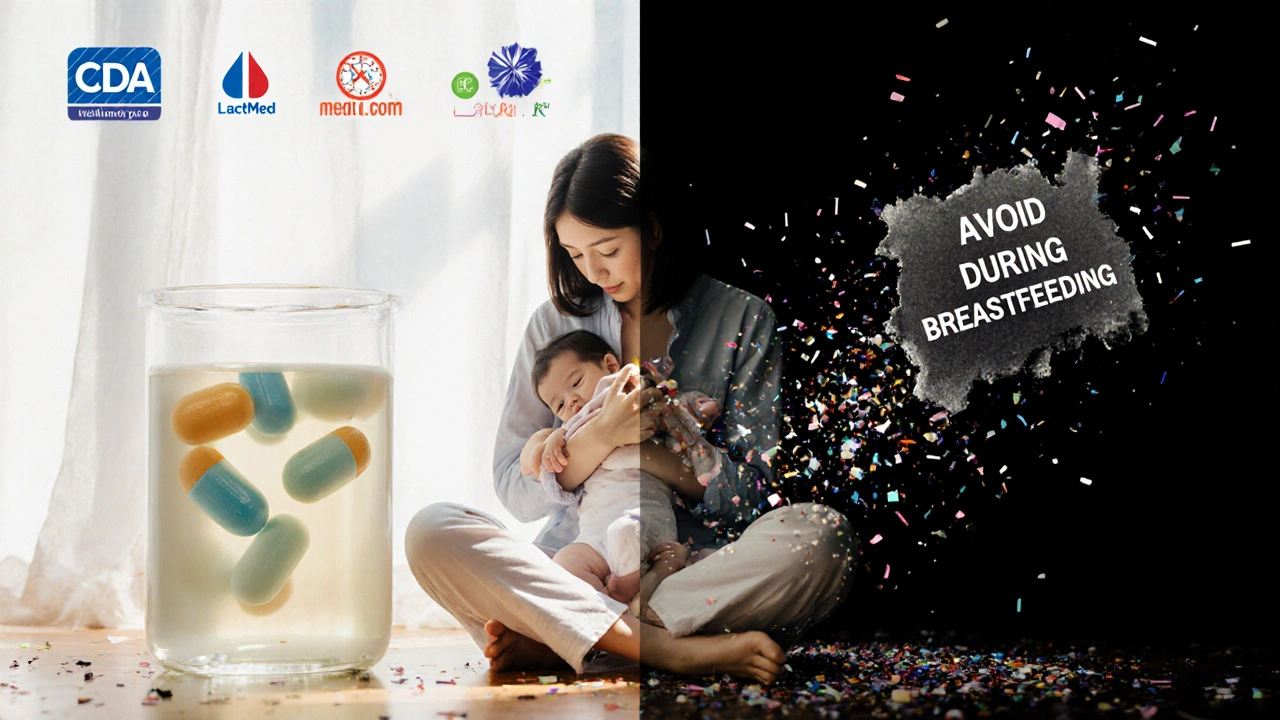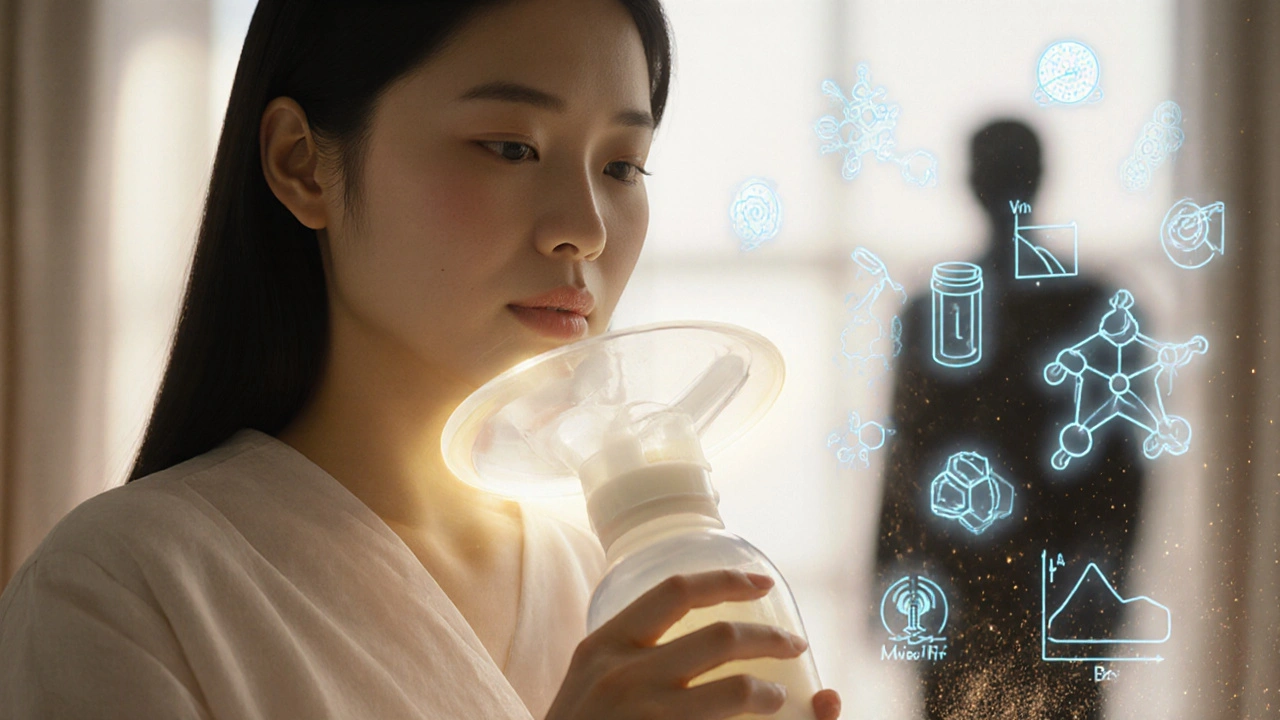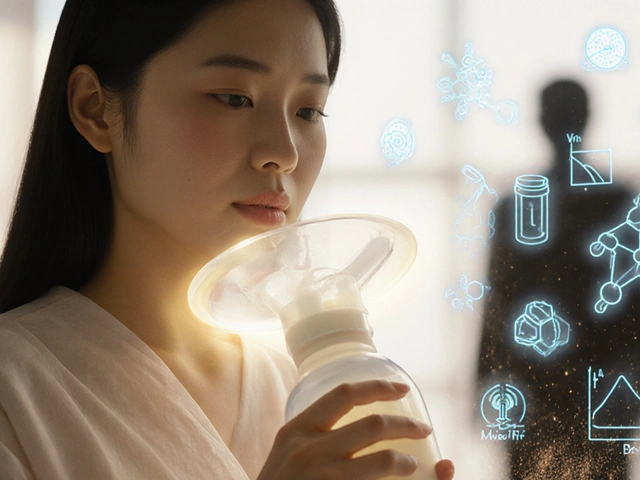Most new moms are told to pump and dump when they need to take medication. It’s a common suggestion - from well-meaning friends, online forums, even some healthcare providers. But here’s the truth: in nearly every case, you don’t need to throw away your breast milk. The idea that all medications contaminate your milk is a myth - one that’s costing mothers their milk supply and their peace of mind.
Why Pump and Dump Is Usually Unnecessary
The phrase "pump and dump" sounds like a safety measure, but it’s often based on outdated warnings on drug labels. Pharmaceutical companies list "avoid during breastfeeding" as a legal precaution, not because the drug is actually dangerous. According to Dr. Thomas Hale’s Medications and Mother’s Milk (18th edition, 2023), only about 2% of medications pose any real risk to breastfed babies. That means 98% are safe to take while nursing. The American Academy of Pediatrics, the American College of Obstetricians and Gynecologists, and the CDC all agree: breastfeeding should continue unless a medication is clearly proven harmful. Medications like radioactive isotopes, certain chemotherapy drugs, or ergot alkaloids are the only ones that truly require stopping breastfeeding - and even then, only temporarily. Yet a 2021 study in the Journal of Human Lactation found that 68% of mothers were incorrectly advised to pump and dump. That’s not just misleading - it’s harmful. When you stop breastfeeding or pumping regularly, your body gets the signal to make less milk. Studies show that skipping just 24 hours of feeding or pumping can drop your supply by 30-50%. For many moms, that drop never fully recovers.How Medications Actually Get Into Breast Milk
Not all drugs transfer the same way. The amount that ends up in your milk depends on several scientific factors:- Molecular weight: Drugs heavier than 500 Daltons (like most antidepressants) struggle to pass into milk.
- Protein binding: If a drug sticks tightly to proteins in your blood (over 80%), very little is free to enter your milk.
- Half-life: Shorter half-life (under 4 hours) means the drug clears your system faster.
- Lipid solubility: Drugs that don’t dissolve easily in fat (log P under 1) don’t move well into milk.
- Infant absorption: Even if a drug gets into milk, your baby’s gut might not absorb it well - especially if it’s poorly absorbed orally.
When Timing Matters More Than Dumping
The smartest way to protect your baby is not by discarding milk - it’s by timing your doses. If you’re taking a medication once a day, take it right after your baby’s longest sleep stretch - usually right after bedtime. That gives your body 6-8 hours to clear most of the drug before the next feeding. For meds taken multiple times a day, breastfeed right before you take the pill. That way, your milk has the lowest drug concentration when your baby feeds. This isn’t guesswork. It’s science-backed timing that keeps your supply steady and your baby safe. A 2022 study in Breastfeeding Medicine showed that moms who used timing strategies maintained their milk supply just as well as those who never took medication.
Safe vs. Risky Medications: Real Examples
Not all drugs are created equal. Here’s what the data says about common ones:| Medication | Type | Relative Infant Dose (%) | Risk Level | Notes |
|---|---|---|---|---|
| Sertraline (Zoloft) | Antidepressant | 0.5-2.5% | Low | Most studied SSRI; no adverse effects reported in over 98% of cases |
| Paroxetine (Paxil) | Antidepressant | 1.5-4.3% | Moderate | Higher transfer; avoid if possible |
| Ibuprofen (Advil) | Pain reliever | 0.01-0.06 mg/L | Low | Preferred over naproxen - naproxen’s long half-life increases risk |
| Naproxen (Aleve) | Pain reliever | 0.1-0.5 mg/L | Moderate | Linked to rare cases of infant anemia and bleeding |
| Cephalexin (Keflex) | Antibiotic | 0.5-1.5% | Low | Safe in over 1,200 documented cases |
| Clindamycin (Cleocin) | Antibiotic | 5-15% | High | Can cause diarrhea in infants; monitor closely |
Notice how many common drugs are low-risk? Most antibiotics, pain relievers, and antidepressants are perfectly safe. The real danger isn’t the medication - it’s the fear that leads you to stop breastfeeding.
What to Do Before Taking Any Medication
You don’t have to figure this out alone. Here’s your action plan:- Check LactMed - This free, NIH-run database (updated weekly) has over 1,300 drug entries with detailed data on transfer rates, infant effects, and safety ratings. Never rely on a drug label alone.
- Call MotherToBaby or InfantRisk Center - Both offer free, expert advice by phone (866-626-6847). They’re staffed by pharmacists and lactation specialists who understand the science.
- Ask your provider for alternatives - If a drug is higher risk, ask if there’s a safer option. For example, sertraline is preferred over paroxetine for depression.
- Use timing, not dumping - Take meds after the longest sleep stretch or right before a feed.
Most doctors don’t know this stuff. A 2021 survey found only 32% of obstetricians and 28% of family physicians could correctly identify safe antidepressants for breastfeeding. Don’t assume your provider knows - give them the resources.
Storage Rules Don’t Change
Whether you’re on medication or not, breast milk storage guidelines stay the same:- Room temperature (up to 25°C): 4 hours
- Refrigerator (≤4°C): 4 days
- Freezer (-18°C): 6 months
Medications don’t alter how milk spoils or breaks down. So if you pumped milk before taking your pill, it’s safe to store and use later. If you pumped after, and the drug is low-risk, it’s still safe to use - unless you’re told otherwise by a specialist.

Real Stories: What Happens When Moms Believe the Myth
One mom in Chicago pumped and dumped for 72 hours after being told to avoid an antibiotic. She didn’t realize cephalosporins are among the safest options. By the time she restarted pumping, her supply had dropped 40%. She had to switch to formula permanently. Another mom in Texas took sertraline while breastfeeding her 6-week-old. She called MotherToBaby, got timing advice, and kept nursing. Her baby showed no side effects. She’s now breastfeeding at 10 months - and credits the right information for making it possible. On Reddit’s breastfeeding community, 63% of mothers reported being told to pump and dump unnecessarily. Nearly half said it damaged their milk supply. The cost isn’t just emotional - it’s financial, physical, and long-term.Where to Get Help - Fast and Free
You don’t need to spend hours searching online. Use these trusted tools:- LactMed - NIH database. Search by drug name. Free. Updated weekly.
- MotherToBaby - Call 866-626-6847. Speak to a specialist. Available in multiple languages.
- InfantRisk Center App - Download the free app. Get instant safety ratings. Used by over 250,000 moms.
- La Leche League - Their Medication Decision Tree (updated quarterly) helps you weigh risks step-by-step.
These aren’t niche resources - they’re the gold standard. Hospitals across the U.S. now use LactMed as their primary reference. The CDC recommends it. The AAP endorses it. And they’re all free.
What’s Changing in 2025
The tide is turning. The FDA is updating drug labeling rules in 2024 to replace vague warnings like "avoid during breastfeeding" with clear, evidence-based guidance. More hospitals are training staff on safe medication use. And moms are starting to push back. The CDC’s 2023-2025 Breastfeeding Plan lists "eliminating unnecessary barriers to breastfeeding during maternal medication use" as a top priority. That means the system is finally catching up to the science. You don’t have to choose between your health and your baby’s. With the right info, you can do both.Do I need to pump and dump if I take ibuprofen?
No. Ibuprofen transfers into breast milk in extremely small amounts - less than 0.01% of your dose. It’s considered one of the safest pain relievers for breastfeeding moms. No pumping or dumping is needed. Take it after a feeding or right before your baby’s longest sleep to be extra cautious.
Is it safe to breastfeed while taking antidepressants?
Yes, most are. Sertraline (Zoloft) is the most studied and safest option, with a relative infant dose of only 0.5-2.5%. Paroxetine is less ideal due to higher transfer rates. Never stop your antidepressant without talking to your doctor - untreated depression is far more dangerous to both you and your baby than the medication.
Can I store milk I pumped while on medication?
Yes, as long as the medication is low-risk. For drugs like acetaminophen, ibuprofen, or cephalexin, stored milk is perfectly safe. Only avoid using stored milk if you’re taking a drug specifically listed as unsafe (like radioactive isotopes). For any uncertainty, check LactMed or call MotherToBaby.
What if my doctor says to pump and dump?
Ask them to check LactMed or call MotherToBaby. Many providers rely on outdated drug labels or hospital protocols that aren’t evidence-based. Bring a printed summary from LactMed or the InfantRisk Center app. Most will change their advice once they see the data.
How long should I wait after taking a pill before breastfeeding?
For most medications, you don’t need to wait at all. If you want to minimize exposure, breastfeed right before taking the pill. For drugs with a short half-life (under 4 hours), waiting 2-3 hours after the dose is usually enough. For longer-acting drugs, timing your dose after the longest sleep stretch is more effective than waiting.




Debanjan Banerjee
November 21, 2025 at 03:03Just want to say this is one of the most well-researched, clear-headed pieces on breastfeeding and meds I’ve ever read. The LactMed and MotherToBaby references alone are worth the read. So many moms are needlessly terrified because of outdated hospital pamphlets. This should be mandatory reading for OBs and pediatricians.
Sandi Moon
November 22, 2025 at 19:58How convenient that this article conveniently ignores the fact that Big Pharma has spent decades suppressing data on drug transfer into breast milk. The FDA’s ‘updated guidelines’? A PR stunt. The real danger isn’t the medication-it’s the institutionalized gaslighting of mothers who dare question the system. Wake up, sheeple.
Kartik Singhal
November 23, 2025 at 08:14Bro… this is just a glorified ad for LactMed. 🤡 I’ve seen this exact post 3x on Reddit. Also, ‘relative infant dose’? That’s not a real metric-it’s a number pharma invented to make their drugs look safe. My cousin’s baby got colic from her Zoloft and she kept pumping ‘cause she trusted this nonsense.
Daisy L
November 24, 2025 at 06:55OH MY GOD. I JUST REALIZED I’VE BEEN DUMPING FOR 8 MONTHS BECAUSE MY DOCTOR SAID ‘JUST IN CASE’-AND I DIDN’T EVEN KNOW I COULD’VE KEPT NURSING?!?!?!?!!?!?!! I’M SO ANGRY I COULD SCREAM. I LOST MY SUPPLY BECAUSE OF A STUPID LABEL AND NOW I HAVE TO BUY FORMULA AND I’M SO SAD AND MAD AND I HATE THE MEDICAL INDUSTRY. 😭💸
Franck Emma
November 25, 2025 at 02:23My wife dumped for 48 hours after a Z-pak. We lost 60% of her supply. Never again. This post saved us.
Eliza Oakes
November 26, 2025 at 08:41Let me guess-you’re one of those moms who thinks ‘low relative infant dose’ means ‘totally harmless.’ Ever heard of cumulative exposure? Or epigenetic effects? Or the fact that infant livers aren’t fully developed? You’re not protecting your baby-you’re just feeding them trace chemicals while patting yourself on the back.
Clifford Temple
November 26, 2025 at 16:24Why are we letting Big Pharma dictate how American mothers feed their babies? This is cultural erosion. We used to trust our instincts. Now we’re told to trust a database run by NIH? We need to go back to traditional ways-herbs, fasting, prayer. Not pills. Not apps. Not science.
Corra Hathaway
November 28, 2025 at 04:20Y’ALL. I JUST CALLED MOTHERTOBABY. THEY ANSWERED IN 2 MINUTES. I ASKED ABOUT MY NAPROXEN AND THEY SAID ‘IT’S FINE IF YOU TIME IT RIGHT.’ I’M CRYING. I’M BREASTFEEDING AT 11 MONTHS AND I FEEL LIKE A SUPERHERO. 🥹💖 YOU ARE NOT ALONE. YOU ARE STRONG. YOU ARE CAPABLE. GO GET THAT MILK. 💪🍼
Paula Jane Butterfield
November 30, 2025 at 00:11Hi, mama. I’m a nurse and I’ve seen this play out a hundred times. You’re not crazy for doubting your doctor. You’re not selfish for wanting to nurse. And you’re not failing if you need meds. I’m so proud of you for reading this. Keep going. You’re doing better than you think. 💛 (And yes, your milk is safe. I promise.)
Simone Wood
December 1, 2025 at 01:33The infant risk dose is statistically insignificant, yes-but we’re talking about a developing neurology here. You can’t unsee the data on neurodevelopmental delays in cohorts exposed to SSRIs in utero and postnatally. This isn’t ‘safe’-it’s ‘acceptable under current regulatory laxity.’
Swati Jain
December 2, 2025 at 08:28OMG I just used this exact guide when I took amoxicillin last week. Pumped right after my baby’s 2am feed, took the pill at 4am, next feed at 7am-zero issues. My baby slept like a log. Also, I told my OB to check LactMed. She didn’t know what it was. 😑
Florian Moser
December 3, 2025 at 19:56This is the kind of info every new mom deserves. No fear. No guilt. Just facts. I’m sharing this with every mom I know. You’ve turned panic into power.
jim cerqua
December 4, 2025 at 22:34Let’s be real-this article is written by someone who’s never held a screaming, sleep-deprived newborn at 3am while juggling 3 meds and a breast pump. The science is great. The reality? You’re lucky if you get 20 minutes to pump. Timing? Ha. You pump when the baby sleeps… if they sleep. This is privileged advice.
Donald Frantz
December 5, 2025 at 20:39What’s the source for the 98% safe stat? Hale’s book is a great resource, but it’s not peer-reviewed meta-analysis. And the 68% misadvised stat-what’s the sample size? Population bias? I need the raw data before I trust this.